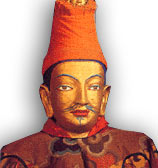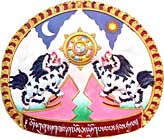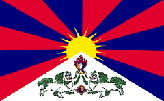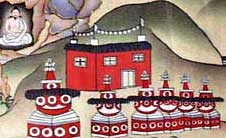Tibetan History
Songtsen Gampo was the first, semi-legendary King of Tibet. He married a Chinese Princess in 640 AD. Under his rule the Tibetan Empire included parts of Burma, Nepal, India and Afghanistan. He allowed Buddhist scholars (from India) into the country and promoted the development of the Tibetan language. He also constructed a Jokhand temple in Lhasa – till this day a most sacred shrine of the Tibetan Buddhism.
Trisong Detsen was another notable Tibetan king. He was the grand-grand-grand son of the legendary Songtsen Gampo and he introduced Buddhism as the state religion in Tibet in 755 AD after a two-year scholars’ debate in Samye Moanstery. His armies took sizable parts of the Chinese territory. Eventually a peace was signed in 821 and its terms were inscribed on three stone pillars, of which one survives in Lhasa till this day. After Trisong Detsen’s death Buddhism went underground and the country fragmented into smaller states. This situation lasted for 400 years.
The Mongol Empire offered Tibet its military protection from 1244 onwards. In return the Tibetan monks provided spiritual guidance to the Mongol Khans. In fact the title of DALAI (meaning ‘the ocean of wisdom’) is a Mongolian title first awarded to Lama Sonam Gyatso by Altan Khan around 1580 AD.
The Mongols re-unite Tibet in 1642. The armies of Gushri Khan managed to re-unite the small states of Tibet under the rule of “The Great Fifth” Dalai Lama. When he died in 1682 his death was kept secret by his Desri (Regent) for 15 years! The Palace of Potala was build during his reign.
Civil war and Chinese rule in the 18th century. After the death of the VI Dalai Lama was revealed most of the country descended into civil war. The weakening Mongol Empire was fighting off rising Chinese power. Eventually in the mid 18th century the Chinese took over control of Tibet, but until 1793 it was more symbolic than real. In this year “29 Articles on the Reconstruction of Tibetan Domestic Affairs” gave the Ambans – Chinese Emperor’s representatives, formal powers over matters of the state.
British Invasion of Tibet in 1904. Fearing that Tsarist Russia might take over Tibet and threaten British interests in colonial India, the British Government sent an expeditionary force to Tibet in 1904 under the command of Francis Younghusband. In the fighting several thousand Tibetans were killed. The formal peace treaty was signed in 1912, which marks the beginning of the recent spell of Tibetan independence. The British brought many new things to Tibet including football and the first lay school in Lhasa. In in the 1920s both were banned by the conservative forces.
Window of independence 1912 - 1950. Only after signing the peace treaty with Great Britain in 1912 did Tibet become a proper sovereign state (for most of its history it was either under Mongol or Chinese influence). The Dalai Lama was the head of state as well as a spiritual leader.
In October 1950 the Chinese Peoples Liberation Army invaded Tibet with 40 thousand soldiers. The Tibetans had only a few thousand men and a few mortars. No military exercise had been conducted for years. Their defeat was swift.
In 1951 the remnants of the Tibetan government was forced to sign a ’17-point Agreement’ giving up the rule over the country to the Chinese State.
The XIV Dalai Lama was initially invited to Beijing and had meetings with Mao Tse Tung, however threatened with imminent arrest escaped to to India in 1959, where he's been living ever since.
Lhasa was the scene of violent riots against Chinese rule in 1959, 1987-89. After 1989 the Tibetan cause became very popular in the West.
The Cultural Revolution of the sixties brought upon a near-destruction of almost 6000 monasteries and countless treasures of art and culture. It was common practice by the authorities to use the holy scriptures from the monasteries as a fertiliser on the fields. The new economic policies had a devastating effect on the economy: e.g. forced replacement of traditional barley with unsuitable wheat resulted in widespread famine.
In 1962 the Panchen Lama wrote a petition to the Chinese Prime Minister Zhou EnLai, in which he criticised the destruction of Tibet by the Chinese Army, the cruelty of the occupying authorities and the starvation of the people. His petition was called a ‘poisoned arrow’ by Mao, Panchen Lama was subsequently subjected to the ‘thamzing' sessions in front of huge rallies of the Red Guards and imprisoned for 15 years.1.2m people are believed to have been killed by repression and famine since the Chinese invasion. Lack of proper records makes it difficult to verify this figure.
Until the 1980s Tibet was closed to foreigners.
Chinese authorities spend significant amounts of money to integrate Tibet into China, but the standard of living in TAR is still far below the Chinese average. The current biggest infrastructure project is building the railway link between Golmud and Lhasa.No Chinese top leader has ever been to Tibet.
The Tibetan flag and the coat of arms shown on this page are banned in Tibet, so are photographs of the Dalai Lama. The coat of arms shows two snow lions supporting the Buddhist Wheel of Life.
You can find out more about the Tibetan history through the Links section of this site.




